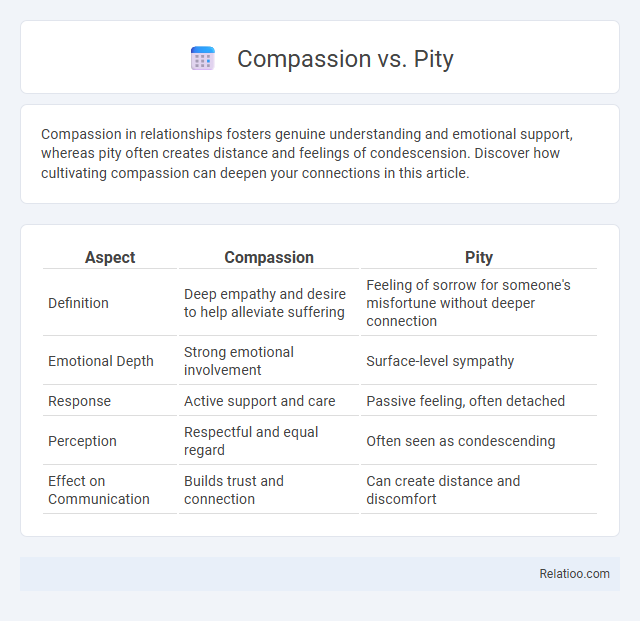Compassion in relationships fosters genuine understanding and emotional support, whereas pity often creates distance and feelings of condescension. Discover how cultivating compassion can deepen your connections in this article.
Table of Comparison
| Aspect | Compassion | Pity |
|---|---|---|
| Definition | Deep empathy and desire to help alleviate suffering | Feeling of sorrow for someone's misfortune without deeper connection |
| Emotional Depth | Strong emotional involvement | Surface-level sympathy |
| Response | Active support and care | Passive feeling, often detached |
| Perception | Respectful and equal regard | Often seen as condescending |
| Effect on Communication | Builds trust and connection | Can create distance and discomfort |
Understanding Compassion and Pity: Key Differences
Understanding compassion and pity involves recognizing that compassion is an empathetic response where you actively share and seek to alleviate another's suffering, while pity often implies a distant, sometimes condescending feeling of sorrow without engagement. Compassion drives you to connect emotionally and offer support, promoting healing and kindness, whereas pity can create a barrier by emphasizing the other person's vulnerability without fostering connection. Embracing compassion over pity enhances your relationships and encourages meaningful assistance grounded in genuine care.
The Emotional Roots of Compassion vs. Pity
The emotional roots of compassion stem from genuine empathy and a deep understanding of another's suffering, leading to a desire to alleviate their pain. Pity often arises from a feeling of superiority or distance, where you recognize suffering but maintain emotional separation, which can inhibit meaningful connection. Compassion, unlike pity, fosters emotional engagement and motivates supportive actions that nurture healing and shared humanity.
Compassion: Empowering Support in Action
Compassion involves actively understanding and sharing the feelings of others, empowering your support through empathy and meaningful action. Unlike pity, which can feel condescending, compassion fosters genuine connection and motivates assistance that respects the dignity of those in need. This empowered approach transforms sympathy into impactful care, driving positive change and healing.
Pity: The Risks of Distance and Disempowerment
Pity often creates emotional distance by positioning the sufferer as inferior or helpless, which can lead to disempowerment rather than support. Unlike compassion, which fosters connection and empathy, pity risks reinforcing negative power dynamics and undermining the dignity of those in need. Recognizing this distinction is vital for promoting respectful and empowering responses to hardship.
How Language Shapes Compassion and Pity
Language profoundly influences how individuals experience and express compassion and pity; compassionate language often emphasizes shared humanity and empathy, fostering connection and support. Pity-related language tends to highlight difference and distance, potentially leading to feelings of superiority or detachment rather than genuine understanding. By consciously choosing words that affirm dignity and commonality, communication can transform pity into compassion, promoting more meaningful and respectful interactions.
Psychological Impact: Recipients’ Perspectives
Compassion fosters emotional connection and support, empowering recipients to feel understood and valued, which enhances psychological resilience. Pity, often perceived as condescending or distancing, can lead to feelings of shame or helplessness, negatively affecting self-esteem. Your emotional well-being improves significantly when compassion, rather than pity or sympathy, is genuinely extended, promoting healing and growth.
Fostering Compassion in Relationships
Fostering compassion in relationships involves recognizing and empathizing with others' emotions without judgment or condescension, which distinguishes compassion from pity that can create distance. Compassion encourages active listening and supportive actions, promoting deeper connection and mutual understanding. Prioritizing empathy and genuine care enhances emotional bonds and nurtures a supportive environment in personal and professional relationships.
Identifying Pity in Social and Cultural Contexts
Pity often involves a sense of superiority and distance, where you view others' suffering as something unfortunate but separate from your own experience. In social and cultural contexts, pity can reinforce power imbalances and stigmatize those in vulnerable positions by emphasizing their weakness rather than shared humanity. Recognizing this distinction helps foster true compassion, which is grounded in empathy and connection rather than judgment or condescension.
Transforming Pity into Compassion: Practical Steps
Transforming pity into compassion involves shifting your perspective from feeling sorry for someone's misfortune to actively understanding and sharing their emotional experience. Engaging in empathetic listening and offering support based on respect rather than judgment helps deepen your connection and promotes healing. Your intentional efforts to cultivate compassion foster genuine care, moving beyond superficial pity to meaningful action.
Choosing Compassion for Genuine Human Connection
Choosing compassion over pity fosters genuine human connection by emphasizing empathy and mutual respect rather than condescension. Compassion involves actively understanding others' pain and offering support without judgment, creating a foundation for authentic relationships. Cultivating compassion encourages deeper emotional bonds and promotes healing, whereas pity often distances people through a sense of superiority.

Infographic: Compassion vs Pity
 relatioo.com
relatioo.com